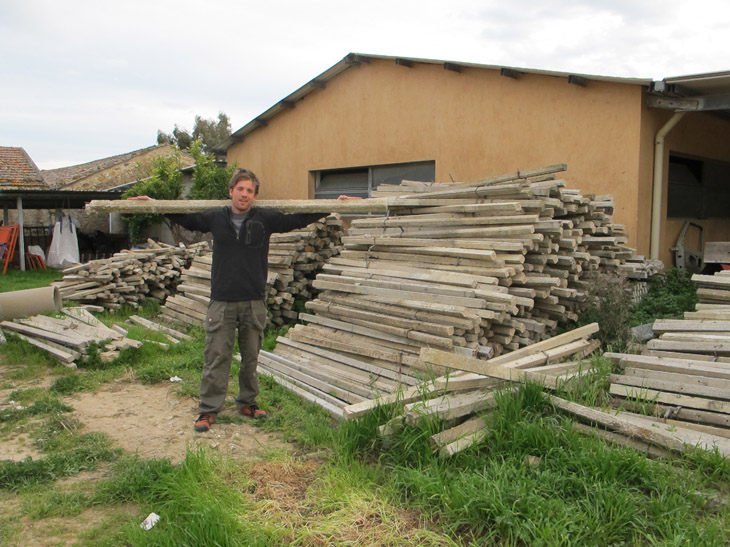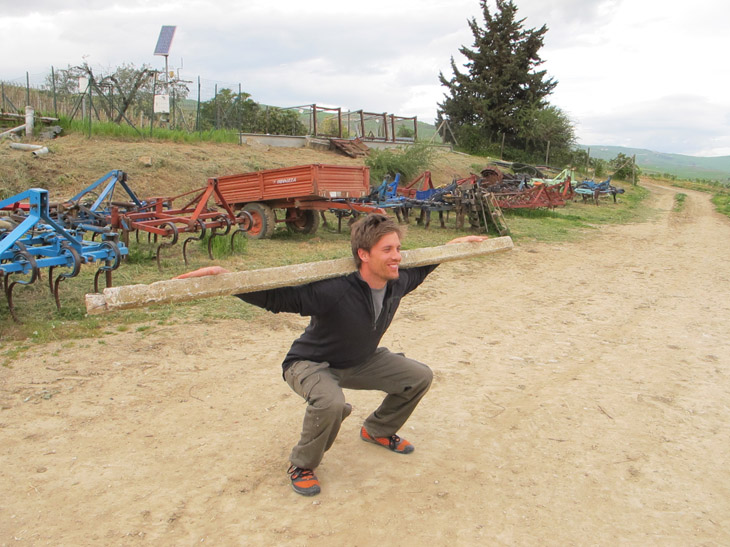Staying fit in Sicily. The ultimate countryside workout
The Case Vecchie Challenge!
Staying fit in Sicily hasn't been easy. We eat ALL of the time. And while I'm a foodie at heart and love to eat (I'm a big eater), the possibly 5,000 + calories I was taking in daily was beginning to weigh me down. Not so much in actual weight, I have a really high metabolism (even at 30!) and I always find that the more meals I have in a day, the faster my engines burn. At any rate, I've always been active, going to the gym, running, cycling, playing sports etc..and after the first few weeks in Sicily, I started to feel like something was missing.
Taking advantage of the massive inclines around Case Vecchie (where I live) and the copious construction material laying around (I live on a vineyard) I set off to design a course, a workout that would rival any cross-fit battleground. Thus out of the darkness, The Case Vecchie Challenge was born! It takes roughly 45 minutes, but I go by Sicilian rules which means, there are no rules. Unlike cross-fit circuits which are usually for reps and for time...The Case Vecchie Challenge... takes as long as it takes and combines interval training, weights using objects found on the estate and of course nutrition. I try and work every muscle group.
Friends and family kept seeing photos of me on Facebook and wondered how, amidst all this delicious food, I was managing to stay in such good shape. Well, this is how I do it!
Challenge1: Interval Training
Interval training is probably one of the best training methods out there. It combines low and high intensity workout exercises that target fast twitch muscle fibers. It's also a great cardiovascular movement.
I start my workout with a short, 10 minute jog to warm my legs and then go immediately into my first sprint interval. I tackle of one Case Vecchies longest and steepest hills. I don't stop until I get to the top! Although I don't count the number of sets, I can usually only manage three interval rounds. If I can squeeze in four...I will, but with only a 2 minute break in between intervals, by the time I'm finished with the third round my legs are shaking. The views at the top are spectacular! Another bonus of sprinting hills.
Challenge 2: Fence Post Lunges
I keep the intensity going, by jogging in between stations and usually go from sprinting into a leg work out to really blast the muscle fibers.
I intersperse the lunges with military shoulder presses using the same post.
Challenge 3: Overhead Military Press
Every set is until failure. Their are usually five sets total. The shoulder press targets both the front and topsides of the muscle group. After these two exercises are carried out I super set with free standing squats.
Challenge 4: Standing Squats
These Squats are mean!! At this point ever rep is difficult, but the concrete posts weigh approximately 20 kilos, so the weight isn't too bad. I give myself 2-3 minute breaks since the rep numbers for this exercise are so high.
Challenge 5: Bicep Busters
Standing bicep curls. 4-5 sets until failure making sure to squeeze at the top. Range of motion is key. Reps are very slow. I mix this exercise with what are known to gym rats as Skull Crushers! Or tricep blasters.
Challenge 6: Skull Crushers
Skull Crushers are one of my favorite exercises, but finding an accessible weight is really important because of the torque it can put on the elbow joints. I superset these as well. One set heavy, followed by one set light to really exhaust the three tricep muscles in each arm.
Challenge 7:Watering Can Rear Deltoid Pulls
The watering can is the perfect tool for shoulder workouts! I actually use it for two different exercises, rear delt pulls and oblique bends. Sorry no picture for these.
Challenge 8:More Sprints!!
Following the rear deltoid exercises a sprint another hill to the top where there is one last shoulder exercise waiting for me.
Challenge 9: Lateral Raises
Using broken concrete posts I alternate front and side shoulder lateral raises. 3-4 sets until failure. And with that, we've got ONE last station. Pull ups! Pull ups are mixed with leg raises to hit the core.
Challenge 10: Pull ups
Using an Ibeam I found in one of the barns, I do pull ups until failure. Usually 4-5 sets mixing the grips to target different parts of the back.
And of course it wouldn't be a proper workout if I didn't carry my hard work all the way through with a Sicilian nutritional plan!
Challenge 11: Nutrition!
The first part of my post work out meal is something sugary to replace all of the glycogen I've spent while working my muscles. I grab an orange from the garden because it's quick and they're delicious.
In general, I tend to eat what I want here at Case Vecchie, which consists of a lot of pasta, so the carbs are more or less covered, but I also eat a lot of wild greens and vegetables as well as lentils and ahem...an egg or two from time to time to make sure I'm getting enough protein. Oh and we grow a number of almond trees in the garden so a handful of nuts is always good to replenish energy and give the body a few extra beneficial fats.
That's pretty much it! I take on The Case Vecchie Challenge 4 days per week. What about you!? Do you have a workout challenge you designed to stay healthy? I'd love to hear about it.























